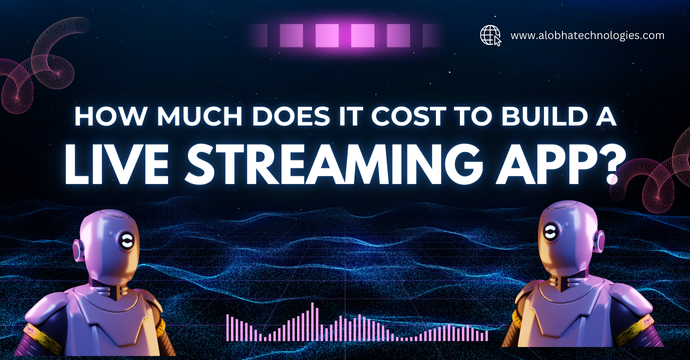
In the digital age, live streaming app has become a significant part of our daily lives. From social media influencers sharing their lives in real-time to businesses hosting virtual events, live-streaming apps are in high demand.
If you’re considering developing a live streaming app, one of your primary questions is, “How much does it cost to build a live-streaming app?” This blog will break down the various factors influencing the cost and provide a comprehensive overview to help you budget for your project effectively.
Understanding the Basics of Live Streaming App
Before diving into the costs, it’s essential to understand what a live streaming app entails. A live streaming app allows users to broadcast video content in real-time to an audience.
Key features typically include user authentication, live video broadcasting, chat functionality, notifications, and cloud storage. Advanced features might also involve monetization options, analytics, and multi-platform support.
Factors Influencing the Cost of Live Streaming App
Several factors can affect the cost of developing a live streaming app, including the complexity of features, the platform (iOS, Android, or both), the technology stack, development team rates, and more. Let’s explore these factors in detail.
App Features and Complexity
The number and complexity of features significantly impact development costs. Here’s a breakdown of essential and advanced features:
Essential Features
- User Registration and Authentication: Basic user management, including sign-up, login, and profile management.
- Live Video Streaming: Core functionality for broadcasting and viewing live streams.
- Chat and Interaction: Real-time messaging and interaction during live streams.
- Notifications: Push notifications for user engagement.
- Basic Analytics: Basic metrics like the number of viewers and stream duration.
Advanced Features
- Monetization Options: In-app purchases, subscriptions, and advertisements.
- Advanced Analytics: Detailed insights into user behavior and stream performance.
- Multi-platform Support: Compatibility with various devices and operating systems.
- High-Quality Streaming: Support for HD or 4K streaming with minimal latency.
- Cloud Storage: Secure storage for saved broadcasts.
Platform Choice
The cost will vary depending on whether you want to develop your app for iOS, Android, or both. Developing for a single platform can be less expensive, but targeting both platforms increases your reach. Cross-platform development frameworks like React Native or Flutter can help reduce costs compared to developing separate native apps.
Technology Stack
The technology stack you choose will affect the cost. Here are some common technologies used in live streaming app development:
- Frontend: Swift (iOS), Kotlin (Android), React Native, Flutter
- Backend: Node.js, Ruby on Rails, Django
- Database: MongoDB, MySQL, Firebase
- Streaming Protocols: RTMP, HLS, WebRTC
- Cloud Services: AWS, Google Cloud, Azure
Development Team
The rates for hiring a development team can vary widely based on their location and expertise. Here’s a general idea of hourly rates:
- North America: $100 – $250 per hour
- Europe: $50 – $150 per hour
- Asia: $20 – $80 per hour
You’ll need a team comprising:
- Project Manager
- UI/UX Designer
- Frontend Developer
- Backend Developer
- QA Tester
Third-Party Services and Integrations
Integrating third-party services can add to the cost but also speed up development and enhance functionality. Common integrations include payment gateways, analytics tools, and content delivery networks (CDNs) like Akamai or Cloudflare for efficient video streaming.
Read More: The Importance of API Integration in App Development
Essential Features to Distinguish Your Live Streaming App
To make your video streaming app stand out in a competitive market, consider incorporating the following key features:
- High-Quality Streaming: Ensure smooth, high-definition video playback with minimal buffering.
- User-Friendly Interface: Create an interface that is both intuitive and visually appealing to ensure easy navigation.
- Personalized Recommendations: Use AI algorithms to suggest content based on user preferences and viewing history.
- Multi-Device Compatibility: Allow users to access the app on various devices, including smartphones, tablets, smart TVs, and desktops.
- Offline Viewing: Provide the option for users to download videos for offline viewing.
- Advanced Search and Filtering: Implement powerful search functionality with filters for genres, ratings, release dates, and more.
- Live Streaming Capabilities: Offer live streaming features for events, sports, and other real-time content.
- Social Sharing: Enable users to share their favorite videos on social media platforms easily.
- Robust Security: Ensure the app is secure with features like encryption, secure payment gateways, and user authentication.
- Monetization Options: Incorporate various monetization strategies such as subscriptions, pay-per-view, and in-app advertisements.
- Interactive Features: Add interactive elements like live chats, polls, and comments to engage users during live streams.
- Multi-Language Support: Cater to a global audience by offering content in multiple languages.
- Analytics and Insights: Provide detailed analytics for users and administrators to track viewing habits and app performance.
By integrating these features, you can create a video streaming app that offers a superior user experience and stands out in the market.
Conclusion
Building a live streaming app is a substantial investment, but with careful planning and a clear understanding of the costs involved, you can create a successful and engaging product. The final cost will depend on various factors, including the complexity of features, the platforms you target, and the expertise of your development team.
By breaking down the process and considering all variables, you can develop a live streaming app that meets your goals and fits your budget. Remember to factor in maintenance and marketing to ensure your app remains competitive and reaches your target audience effectively.